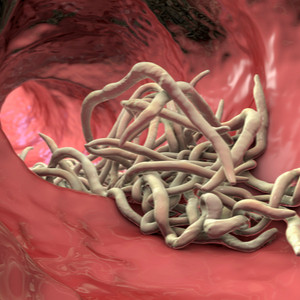
Fruit and vegetables can be contaminated with roundworm eggs through improper fertilisation (faecal fertilisation).
Infected people excrete these very resistant eggs in their stool and are therefore infectious.
Ascaris lumbricoides, also known as roundworm, is an infestation of the intestine.
Worldwide, about 760 million to 1.4 billion people are infected with this worm. The risk areas are mainly East Asia, Africa and Latin America.
Male roundworms grow up to 25 centimetres long, females even up to 40 centimetres.
Although roundworms can usually feed in several organisms, they only reproduce in their final host.
| Roundworm | Main host |
| Ascaris lumbricoides | Human |
| Ascaris suum | Pig |
| Ascaris marina | Marine animals |
| Ascaris canis | Dog |
| Ascaris cati | Cat |
Human-to-human infection is impossible in the case of roundworm, and this is because the eggs of the worm must first mature outside the body in a warm and humid environment of about 30 degrees before they become infectious.
If these eggs are then ingested after about two to six weeks of maturation through contaminated food, these larvae can hatch in the small intestine and infect humans.
First they pierce the wall of the small intestine and thus reach the liver via the intestinal veins.
Then, after another five to ten days, they migrate further along the bloodstream via the right heart into the lungs.
At the age of about a week, they break through the vessels and settle in the alveoli. There they shed their skin and crawl up the bronchi and trachea towards the throat.
There they irritate the mucous membrane and trigger a swallowing reflex. The human swallows the young worms and thus transports them via the oesophagus into the stomach and finally back into the small intestine.
Here the worms become sexually active and produce their first eggs after about 70 days, after they have entered the human organism for the first time.
Normally, the infection is asymptomatic. However, complaints such as cough, shortness of breath, asthma-like symptoms, Löffler syndrome with eosinophilic lung infiltrates can occur.
These complaints are the result of the larvae migrating into the lungs.
7-9 weeks after the initial infection, worms can be detected in the stool for the first time.
If you visualise the path of the larvae in the body, the symptoms become clear:
Migration of the larvae into the blood and lungs:
- Granulocytes in the blood increase
- Irritative cough
- Bronchitis
- Sometimes fever
- Allergic reactions to the metabolic products of the worms
Continuation of the worms in the intestine:
- Upper abdominal discomfort
- Diarrhoea or constipation or alternately
- Loss of appetite
- Sleep disturbances
- Nervousness
Complications
- Obstruction of the small intestine, bile ducts, pancreatic duct or appendix by worm balls
- Intestinal obstruction (possibly fatal)
- Inflammation of the pancreas or bile ducts
If a worm infestation is suspected, a doctor must be consulted.
The following frequency lists are only intended to support conventional medical therapy!
